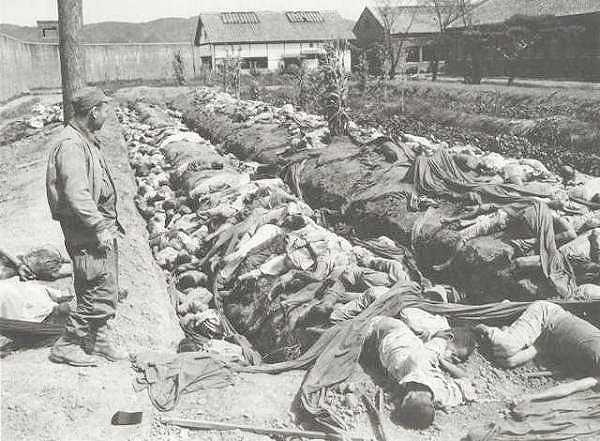With the capture of Taejon, the 24th Division accomplished its mission in the pursuit. And sweet revenge it was for the Taro Leaf Division to re-enter this now half-destroyed town where it had suffered a disastrous defeat nine weeks earlier. Fittingly enough, it was the 19th Infantry Regiment and engineers of the 3d Engineer Combat Battalion, among the last to leave the burning city on that earlier occasion, who led the way back in. But there was bitterness too, for within the city American troops soon discovered that the North Koreans had perpetrated there one of the greatest mass killings of the entire Korean War. American soldiers were among the victims.
While this is not the place to tell in detail the story of the North Korean atrocities perpetrated on South Korean civilians and soldiers and some captured American soldiers, an account of the breakout and pursuit would not be complete without at least a brief description of the grisly evidence that came to light at that time. Everywhere the advancing columns found evidence of atrocities as the North Koreans hurried to liquidate political and military prisoners held in jails before they themselves retreated in the face of the U.N. advance. At Sach'on the North Koreans burned the jail, causing some 280 South Korean police, government officials, and landowners held in it to perish. At Anui, at Mokp'o, at Kongju, at Hamyang, at Chonju, mass burial trenches containing the bodies of hundreds of victims, including some women and children, were found, and near the Taejon airstrip the bodies of about 500 ROK soldiers, hands tied behind backs, lay in evidence of mass killing and burial.
Between 28 September and 4 October a frightful series of killings and burials were uncovered in and around the city. Several thousand South Korean civilians, estimated to number between 5,000 and 7,000, 17 ROK Army soldiers, and at least 40 American soldiers had been killed. After Taejon fell to the North Koreans on 20 July civilian prisoners had been packed into the Taejon city jail and still others into the Catholic Mission. Beginning on 23 September, after the first U.S. troops had crossed the Naktong, the North Koreans began executing these people. They were taken out in groups of 100 and 200, bound to each other and hands tied behind them, led to previously dug trenches, and shot. By 26 September American forces had approached so close to Taejon that the N.K. Security Police knew they had to hurry. The executions were speeded up and the last of them took place just before the city fell.
Of the thousands of victims only six survived-two American soldiers, one ROK soldier, and three South Korean civilians. Wounded and feigning death, they had been buried alive. The two wounded Americans had only a thin layer of loose soil over them, enabling them to breathe sufficiently to stay alive until they could punch holes to the surface, one of them with a lead pencil. Still wired to their dead comrades beneath the soil and partially buried themselves, they were rescued when the city fell to the 24th Division. Hundreds of American soldiers, including General Milburn, the I Corps commander, and General Church, the 24th Division commander, saw these ghastly burial trenches and the pathetic bodies of the victims. [37]
South to the Naktong, North to the Yalu, Roy E. Appleman, pp587-588


